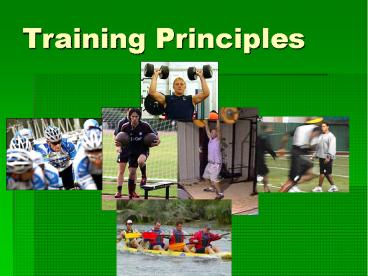Training Principles - PowerPoint PPT Presentation
Title:
Training Principles
Description:
Training Methods Periodization Concurrent training Interval training Fartlek training Resistance training Plyometric ... power-lifters, basketball & football ... – PowerPoint PPT presentation
Number of Views:348
Avg rating:3.0/5.0
Title: Training Principles
1
Training Principles
2
Types of Training Principles
- The Principle of Overload
- The Principle of Progression
- The Principle of Specificity (or S.A.I.D.)
- The Principle of Individual Differences
- The Principle of Reversibility
- The Principle of Diminishing Returns
- The Principle of Overtraining
3
Overload
- To get stronger, the body must perform tasks that
are more challenging than those to which it is
accustomed - Over time the body will adapt
- New demands must be incorporated
- Overload can include all aspects of training,
i.e., physiological, emotional, mental, and
psychological - Aerobic (gt55)
- Anaerobic (80)
- Size (70)
- Strength (85)
- Speed (95)
4
Progression
- In order to constantly improve, an athlete must
progressively increase the overload over time - The athlete must be aware that loads and demands
on the body must occur over time to increase
performance and decrease injury - 10 Rule An athlete shouldnt increase the
training volume more than 10/ week
5
Specificity
- In order for specific outcomes to occur, training
must be specific to those outcomes - Example if you need to improve your vertical
jump, your exercise prescription should include
explosive power such as exercises that target the
legs - Specific muscle adaptations will occur if
training is specific - Training must reflect athletes game situation
needs
6
Individual Differences
- Every athlete has a different physical and
psychological makeup - Pre-training fitness levels
- Requirements within their sport
- Age and gender
- Ability to recover from workouts
- Ability to recover from injury
7
Reversibility
- Use it or lose it
- Detraining
- Loss of ones edge
- Loss in intensity
- Atrophy (decreased muscle mass)
- Reasons include
- - injury
- - lack of motivation
- - overtraining
- - burnout
8
Diminishing Returns
- A persons training gains will reflect that
persons prior level of training - Performance plateau
- Must change exercise prescription
- Ethical vs. unethical training methods
9
Overtraining
- Excess volume or intensity of training, or both
resulting in fatigue - Can also be due to lack of proper rest and
recovery. Rest is critical to make you stronger
to allow for recovery. - The treatment for overtraining is rest.
10
Training Methods
- Periodization
- Concurrent training
- Interval training
- Fartlek training
- Resistance training
- Plyometric training
11
Periodization
- Breakdown of year-long training
- Three major seasons
- 1) off-season recovery from potential in-season
injuries, could involve some cross training,
begin specific training for specific goals - 2) pre-season max performance gains to peak
for the beginning of the season, - 3) in-season attempt to maintain gains made
during off season training
12
Concurrent
- Training all energy systems at the same time
- Different types of training simultaneously
- Great for general fitness (circuit training)
- Performed during the off-season for certain
athletes - Ideal for keeping variety in ones exercise
program
13
Interval
- Can benefit both anaerobic and aerobic systems
- Alternating periods of intensity within a given
workout - Great for lactic acid training threshold
- Manipulates length of intense period, its
intensity, length of rest, and number of
repetitions
14
Resistance
- Lifting weights is the most common form
- Weight provides resistance to muscles
- Broken down into number of
- sets, repetitions, rest, tempo (speed of
repetition), loads, and volume
15
Plyometics
- Stretch-shortening exercises
- These exercises must be a movement followed by an
eccentric (lengthening) contraction.. - Examples include bounding, hopping, jumping, box
jumps, box drills - Develops strength and power
- For explosive sports/ activities
- (sprinters, power-lifters, basketball
football players) - Children should also avoid repeated long, high
intense plyometric routines. - (too much stress on the joints)































